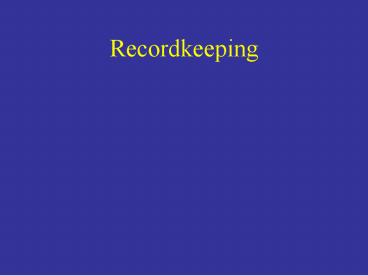Recordkeeping - PowerPoint PPT Presentation
1 / 31
Title:
Recordkeeping
Description:
The information is generally related to injury frequency and illness incidence ... Drilling a fingernail to drain the fluid and relieve the pressure? No ... – PowerPoint PPT presentation
Number of Views:312
Avg rating:3.0/5.0
Title: Recordkeeping
1
Recordkeeping
2
Safety Recordkeeping
- OSHA mandates some recordkeeping
- Project owners often require some forms of safety
recordkeeping - Employers are wise to implement other forms of
recordkeeping
3
Why Does OSHA Mandate Recordkeeping?
- The information is generally related to injury
frequency and illness incidence - Trends can be observed over time
- OSHA recordkeeping requirements is that this
information can be useful to OSHA as it seeks
direction in its mission - Tells industry how it is doing
4
OSHA Recording Requirements(for Firms with 11 or
more employees)
- OSHA Log No. 300 (Each injured worker is named,
the extent of the injury, or the nature of the
illness). Recordable only. - OSHA Supplementary Record No. 301 (formerly 101)
5
In 2004 Additional Reporting
- Beginning January 2004
- Employers will be required to report work-related
hearing loss - Must record 10-decibel shifts from the employees
baseline hearing test (resulting in an overall
hearing loss of 25 decibels) - Musculoskeletal disorders (MSDs) reporting
requirements are postponed
6
What is Recordable?
- Requires treatment by a physician
- Worker becomes unconscious
- Worker ability to work is restricted
- Re-injury requiring treatment
- Injuries occurring off-site needing treatment
- Injury must be work-related
7
What is not Recordable?
- First aid treatment only
- Observation by a physician but not treated
- Hospitalized but not treated
8
Are the following Recordable?
- Treatment limited to cleaning, soaking, applying
antiseptic and bandaging a wound? - No
- Medical glue was applied to close multiple
lacerations?
Yes
9
Are the following Recordable?
- Applying non-prescription ointments on follow-up
visits to prevent drying and cracking of skin? - No
- Butterfly bandages were applied to multiple
lacerations?
No
10
Are the following Recordable?
- Removal of embedded foreign material from the
eye? - Yes
- Second or subsequent hot and cold soaks and use
of whirlpool treatments?
No
11
Are the following Recordable?
- Drilling a fingernail to drain the fluid and
relieve the pressure? - No
- One-time administration of oxygen for several
minutes?
Yes
12
Are the following Recordable?
- Following a chest X-ray, an employee was
diagnosed with silicosis? - Yes
- One-time administration of prescription
medication to alleviate minor discomfort?
Yes
13
Are the following Recordable?
- Additional cleaning and application of antiseptic
because the bandage became soiled? - No
- Medical removal as mandated by OSHA standard due
to cadmium poisoning?
Yes
14
Are the following Recordable?
- Employee injures back at work and has one
chiropractic adjustment? - Yes
- Loss of consciousness?
Yes
15
Are the following Recordable?
- Following an X-ray of a rib for a fracture, X-ray
indicates the rib is not broken? - No
- Reaction to flu shot administered on-site on a
voluntary basis?
No
16
Are the following Recordable?
- The injury is the result of choking on a sandwich
from the employees brown bag lunch? - No
- Adding eye drops to eye in order to dilate pupils
for diagnostic purposes?
No
17
Are the following Recordable?
- Needlestick from sharp object contaminated with
potentially infectious material? - Yes
- Employee with work-related elbow pain and is
given non-prescription pain medication at
prescription strength?
Yes
18
OSHA Supplementary Record No. 301
- Provides details of a single injury
- Similar to information requested by workers
compensation carriers
19
Maintain Good Records
- Log 300 and No. 301 (formerly 101) to be on site
at all times - Central dispatch office can be used for records
if workers begin workday there - Keep records for 5 years
20
The Annual Summary ReportForm 300A
- Posted at the place of employment from February 1
to May 1 (3 months) - Summary to include type of injury and the number
of lost workdays - If no injuries, post with zeroes on the total
lines
21
Other Recordkeeping
- First Aid and Medical Assistance
- First Aid Supplies and Medical Service Available
- Employees Informed of Medical Results
- Emergency Procedures and Training, Where
Necessary - Surveillance Records Asbestos, Lead
22
Accident Investigations
- Detailed analysis of what happened
- Witness accounts, etc.
- Reasonable options to avoid further occurrence
- Communication of findings
23
In How Many Recordable Injuries is Top Management
Involved in the Investigation?
24
Documenting Near Misses
- To Conduct Trend Analysis
- Be Aware of Problems before an Injury Occurs
25
Number of Near Misses Documented per Project
26
Worker Observations
- Document unsafe behavior
- Conduct trend analysis
- Worker involvement in the process
- No name, no blame
27
Number of Observations Recorded
28
Identification of Safety Violations
- Reprimands
- Terminations
29
(No Transcript)
30
Are Sanctions in Place for Subcontractors Who Do
Not Comply With Safety Requirements?
31
(No Transcript)































